Empirical Modelling of Vegetation Abundance from Airborne Hyperspectral Data for Upland Peatland Restoration Monitoring
Abstract
:1. Introduction
2. Method
2.1. Study Area
2.2. Data Acquisition
2.3. Sensitivity Analysis to Class Generalisation
2.4. Regression Modelling
3. Results
3.1. Class Sensitivity
3.2. Latent Factors of the PLSR
3.3. PLSR Variable Selection
3.4. PLSR Validation
3.5. Application to the Image; Spatial Prediction
4. Discussion
5. Conclusions
Acknowledgments
Author Contributions
Conflicts of Interest
References
- Davies, A. Review of the Historical Environmental Changes in the UK Uplands Relevant to Management and Policy. In Foundations for the Future: Learning from the Past; University of Sterling: Stirling, UK, 2008; p. 62. [Google Scholar]
- Bain, C.G.; Bonn, A.; Stoneman, R.; Chapman, S.; Coupar, A.; Evans, M.; Gearey, B.; Howat, M.; Joosten, H.; Keenleyside, C.; et al. IUCN UK Commission of Inquiry on Peatlands; IUCN UK Peatland Programme: Edinburgh, UK, 2011. [Google Scholar]
- Moore, P.D. The future of cool temperate bogs. Environ. Conserv 2002, 29, 3–20. [Google Scholar]
- Pearce-Higgins, J.; Grant, M.; Beale, C.M.; Buchanan, G.; Sim, I. International Importance and Drivers of Change of Upland Bird Populations. In Drivers of Environmental Change in Uplands; Bonn, A., Allott, T., Hubacek, K., Stewart, J., Eds.; Routledge: London, UK, 2009; pp. 209–227. [Google Scholar]
- Thompson, D.B.A.; MacDonald, A.J.; Marsden, J.H.; Galbraith, C.A. Upland heather moorland in Great Britain: A review of international importance, vegetation change and some objectives for nature conservation. Biol. Conserv 1995, 71, 163–178. [Google Scholar]
- Ramchunder, S.J.; Brown, L.E.; Holden, J. Environmental effects of drainage, drain-blocking and prescribed vegetation burning in UK upland peatlands. Prog. Phys. Geogr 2009, 33, 49–79. [Google Scholar]
- Tallis, J.H. Growth and degradation of British and Irish blanket mires. Environ. Rev 1998, 6, 81–122. [Google Scholar]
- Bonn, A.; Rebane, M.; Reid, C. Ecosystem Services. A New Rationale for Conservation of Upland Environments. In Drivers of Change in Upland Environments; Bonn, A., Allott, T., Hubacek, K., Stewart, J., Eds.; Routledge: London, UK, 2009; pp. 448–474. [Google Scholar]
- Holden, J.; Shotbolt, L.; Bonn, A.; Burt, T.P.; Chapman, P.J.; Dougill, A.J.; Fraser, E.D.G.; Hubacek, K.; Irvine, B.; Kirkby, M.J.; et al. Environmental change in moorland landscapes. Earth-Sci. Rev 2007, 82, 75–100. [Google Scholar]
- Van der Wal, R.; Bonn, A.; Monteith, D.T.; Reed, M.; Blackstock, K.; Hanley, N.; Thompson, D.; Evans, M.; Alonso, I. Mountains, Moorlands and Heaths; United Nations Environment Program-World Conservation Monitoring Centre: Cambridge, UK, 2011. [Google Scholar]
- Worrall, F.; Burt, T.; Adamson, J.; Reed, M.; Warburton, J.; Armstrong, A.; Evans, M. Predicting the future carbon budget of an upland peat catchment. Clim. Chang 2007, 85, 139–158. [Google Scholar]
- Bellamy, P.H.; Loveland, P.J.; Bradley, R.I.; Lark, R.M.; Kirk, G.J.D. Carbon losses from all soils across England and Wales 1978–2003. Nature 2005, 437, 245–248. [Google Scholar]
- Sieben, E.J.J. Plant functional composition and ecosystem properties: The case of peatlands in South Africa. Plant Ecol 2012, 213, 809–820. [Google Scholar]
- Lavorel, S.; McIntyre, S.; Landsberg, J.; Forbes, T.D.A. Plant functional classifications: From general groups to specific groups based on response to disturbance. Trend. Ecol. Evol 1997, 12, 474–478. [Google Scholar]
- Schumann, M.; Joosten, H. Global Peatland Restoration Manual; Institute of Botany and Landscape Ecology, Greifswald University: Greifswald, Gremany, 2008; p. 64. [Google Scholar]
- Aplin, P. Remote sensing: Ecology. Prog. Phys. Geogr 2005, 29, 104–113. [Google Scholar]
- Gillespie, T.W.; Foody, G.M.; Rocchini, D.; Giorgi, A.P.; Saatchi, S. Measuring and modelling biodiversity from space. Prog. Phys. Geogr 2008, 32, 203–221. [Google Scholar]
- Turner, W.; Spector, S.; Gardiner, N.; Fladeland, M.; Sterling, E.; Steininger, M. Remote sensing for biodiversity science and conservation. Trend. Ecol. Evol 2003, 18, 306–314. [Google Scholar]
- Medcalf, K.A.; Parker, J.A.; Turton, N.; Finch, C. Making Earth Observation Work for UK Biodiversity Conservation—Phase 1; Project Code: CR 0477; Joint Nature Conservation Committee: Peterborough, UK, 2011. [Google Scholar]
- Petchey, S.; Brown, K.; Hambidge, C.; Porter, K.; Rees, S. Operational Use of Remote Sensing for Environmental Monitoring; Joint Report JP001; Natural England: Sheffield, England, 2011. [Google Scholar]
- Mehner, H.; Cutler, M.; Fairbairn, D.; Thompson, G. Remote sensing of upland vegetation: The potential of high spatial resolution satellite sensors. Glob. Ecol. Biogeogr 2004, 13, 359–369. [Google Scholar]
- Aplin, P. On scales and dynamics in observing the environment. Int. J. Remote Sens 2006, 27, 2123–2140. [Google Scholar]
- Mehner, H.; Fairbairn, D.; Cutler, M. Defining the Optimal Spatial Resolution for Mapping Upland Vegetation. In proccedings of RSPSoc Annual Conference 2004: Remote Sensing and Photogrammetry Society: Mapping and Resources Management, Aberdeen, UK, 6–10 September 2004.
- Tallis, J.H. Peat erosion in the Pennines: The badlands of Britain. Biologist 1997, 44, 277–279. [Google Scholar]
- Elkington, T.; Dayton, N.; Jackson, D.L.; Strachan, I.M. National Vegetation Classification Field Guide to Mires and Heaths; Joint Nature Conservation Committee: Peterborough, UK, 2002. [Google Scholar]
- Asmat, A.; Milton, E.J.; Atkinson, P.M. Empirical correction of multiple flightline hyperspectral aerial image mosaics. Remote Sens. Environ 2011, 115, 2664–2673. [Google Scholar]
- McMorrow, J. Linear regression modelling for the estimation of oil palm age from Landsat TM. Int. J. Remote Sens 2001, 22, 2243–2264. [Google Scholar]
- Schaepman-Strub, G.; Limpens, J.; Menken, M.; Bartholomeus, H.M.; Schaepman, M.E. Towards spatial assessment of carbon sequestration in peatlands: Spectroscopy based estimation of fractional cover of three plant functional types. Biogeosciences 2008, 6, 275–284. [Google Scholar]
- Cole, B.; McMorrow, J.; Evans, M.G. Spectral monitoring of moorland plant phenology to identify a temporal window for hyperspectral remote sensing of peatland. ISPRS J. Photogramm. Remote Sens 2013, in press. [Google Scholar]
- Schmidtlein, S. Imaging spectroscopy as a tool for mapping Ellenberg indicator values. J. Appl. Ecol 2005, 42, 966–974. [Google Scholar]
- Schmidtlein, S.; Sassin, J. Mapping of continuous floristic gradients in grasslands using hyperspectral imagery. Remote Sens. Environ 2004, 92, 126–138. [Google Scholar]
- Schmidtlein, S.; Feilhauer, H.; Bruelheide, H. Mapping plant strategy types using remote sensing. J. Veg. Sci 2012, 23, 395–405. [Google Scholar]
- Curran, P.J. Imaging spectrometry. Prog. Phys. Geogr 1994, 18, 247–266. [Google Scholar]
- Kumar, L.; Schmidt, K.; Dury, S.J.; Skidmore, A. Imaging Spectrometry and Vegetation Science. In Imaging Spectrometry: Basic Principles and Prospective Applications; van der Meer, F.D., de Jong, S.M., Eds.; Kluwer Academic Publishers: Dordrecht, The Netherlands, 2001; pp. 111–155. [Google Scholar]
- Schlerf, M.; Atzberger, C.; Hill, J. Remote sensing of forest biophysical variables using HyMap imaging spectrometer data. Remote Sens. Environ 2005, 95, 177–194. [Google Scholar]
- Atzberger, C.; Guerif, M.; Baret, F.; Werner, W. Comparative analysis of three chemometric techniques for the spectroradiometric assessment of canopy chlorophyll content in winter wheat. Comput. Electron. Agric 2010, 73, 165–173. [Google Scholar]
- Huang, Z.; Turner, B.J.; Dury, S.J.; Wallis, I.R.; Foley, W.J. Estimating foliage nitrogen concentration from HYMAP data using continuum removal analysis. Remote Sens. Environ 2004, 93, 18–29. [Google Scholar]
- Cho, M.A.; Skidmore, A.; Corsi, F.; van Wieren, S.E.; Sobhan, I. Estimation of green grass/herb biomass from airborne hyperspectral imagery using spectral indices and partial least squares regression. Int. J. Appl. Earth Obs. Geoinf 2007, 9, 414–424. [Google Scholar]
- Feilhauer, H.; Asner, G.P.; Martin, R.E.; Schmidtlein, S. Brightness-normalized partial least squares regression for hyperspectral data. J. Quant. Spectrosc. Radiat. Transf 2010, 111, 1947–1957. [Google Scholar]
- Hansen, P.M.; Schjoerring, J.K. Reflectance measurement of canopy biomass and nitrogen status in wheat crops using normalized difference vegetation indices and partial least squares regression. Remote Sens. Environ 2003, 86, 542–553. [Google Scholar]
- Gomez, C.; Rossel, R.A.V.; McBratney, A.B. Soil organic carbon prediction by hyperspectral remote sensing and field vis-NIR spectroscopy: An Australian case study. Geoderma 2008, 146, 403–411. [Google Scholar]
- Viscarra Rossel, R.A.; Walvoort, D.J.J.; McBratney, A.B.; Janik, L.J.; Skjemstad, J.O. Visible, near infrared, mid infrared or combined diffuse reflectance spectroscopy for simultaneous assessment of various soil properties. Geoderma 2006, 131, 59–75. [Google Scholar]
- Feilhauer, H.; Faude, U.; Schmidtlein, S. Combining Isomap ordination and imaging spectroscopy to map continuous floristic gradients in a heterogeneous landscape. Remote Sens. Environ 2011, 115, 2513–2524. [Google Scholar]
- Rosipal, R.; Krämer, N. Overview and Recent Advances in Partial Least Squares. In Subspace, Latent Structure and Feature Selection Techniques; Saunders, C., Grobelnik, M., Gunn, S., Shawe-Taylor, J., Eds.; Springer: Berlin Heidelberg, Gremany, 2006; pp. 35–51. [Google Scholar]
- Wold, S.; Sjostrom, M.; Eriksson, L. PLS-regression: A basic tool of chemometrics. Chemom. Intell. Lab. Syst 2001, 58, 109–130. [Google Scholar]
- Cheriyadat, A.; Bruce, L.M. Why Principal Component Analysis is not an Appropriate Feature Extraction Method for Hyperspectral Data. Proceedings of the 2003 IEEE International Geoscience and Remote Sensing Symposium, IGARSS ’03, Toulouse, France, 21–25 July 2003; pp. 3420–3422.
- Onojeghuo, A.O.; Blackburn, G.A. Optimising the use of hyperspectral and LiDAR data for mapping reedbed habitats. Remote Sens. Environ 2011, 115, 2025–2034. [Google Scholar]
- Höskuldsson, A. Variable and subset selection in PLS regression. Chemom. Intell. Lab. Syst 2001, 55, 23–38. [Google Scholar]
- SAS. The PLS Procedure. In SAS/STAT (R) 9.2 User’s Guide, 2nd ed.; SAS Institute Inc.: Cary, NC, USA, 2012. [Google Scholar]
- Kubinyi, H. Evolutionary variable selection in regression and PLS analyses. J. Chemom 1996, 10, 119–133. [Google Scholar]
- Martens, H.; Martens, M. Modified Jack-knife estimation of parameter uncertainty in bilinear modelling by partial least squares regression (PLSR). Food Qual. Prefer 2000, 11, 5–16. [Google Scholar]
- Curran, P.J. Remote-sensing of foliar chemistry. Remote Sens. Environ 1989, 30, 271–278. [Google Scholar]
- Wold, S. PLS for multivariate linear modelling. Chemom. Methods Mol. Des 1995, 2, 195–218. [Google Scholar]
- Curran, P.J.; Dungan, J.L.; Macler, B.A.; Plummer, S.E. The effect of a red leaf pigment on the relationship between red edge and chlorophyll concentration. Remote Sens. Environ 1991, 35, 69–76. [Google Scholar]
- Nagler, P.L.; Daughtry, C.S.T.; Goward, S.N. Plant litter and soil reflectance. Remote Sens. Environ 2000, 71, 207–215. [Google Scholar]
- Ustin, S.L.; Gamon, J.A. Remote sensing of plant functional types. New Phytol 2010, 186, 795–816. [Google Scholar]
- Cutler, M.; McMorrow, J.; Evans, M. Remote sensing of upland peat erosion in the Southern Pennines. North West Geogr 2002, 2, 21–30. [Google Scholar]
- Cherrill, A.; McClean, C. Between-observer variation in the application of a standard method of habitat mapping by environmental consultants in the UK. J. Appl. Ecol 1999, 36, 989–1008. [Google Scholar]
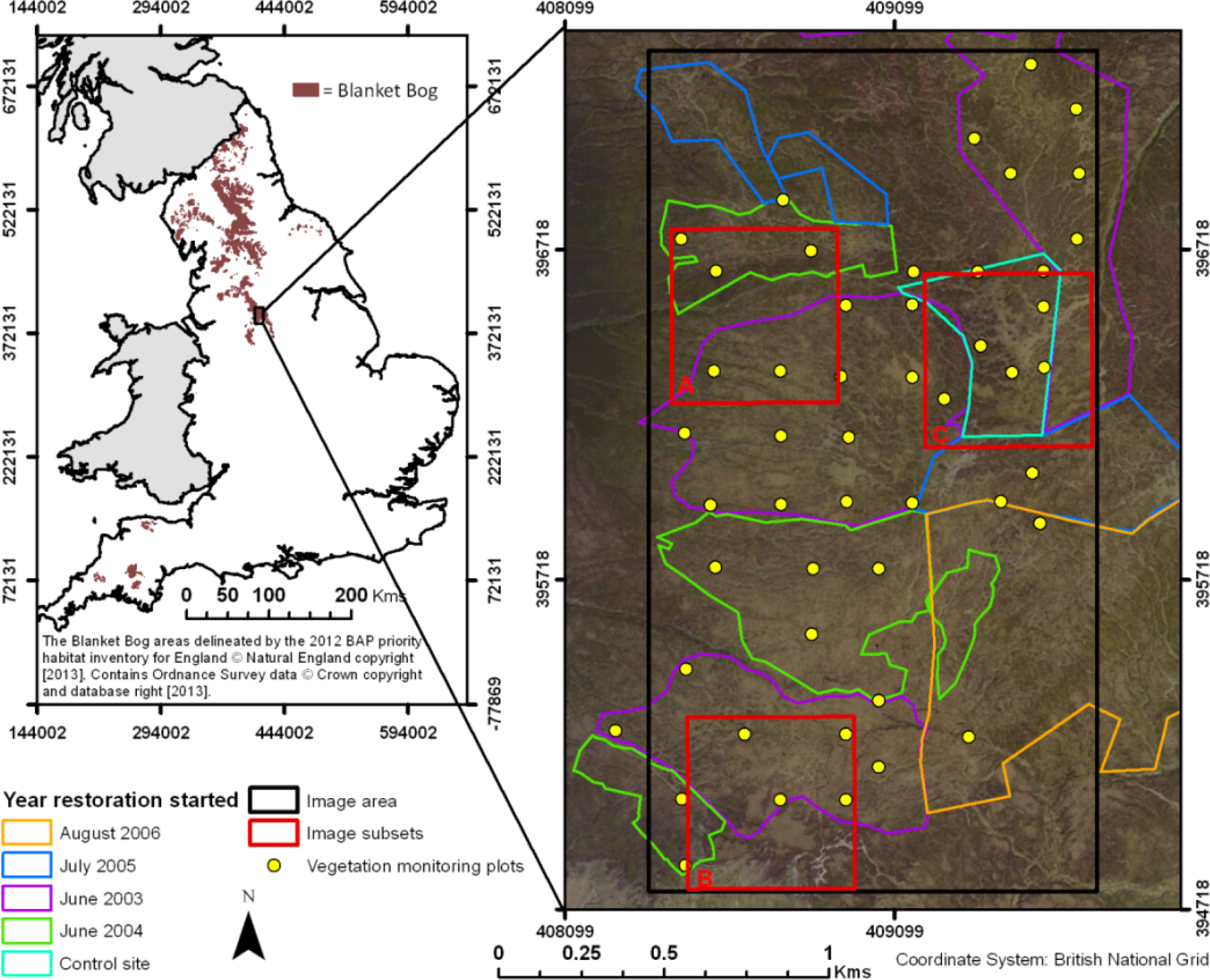

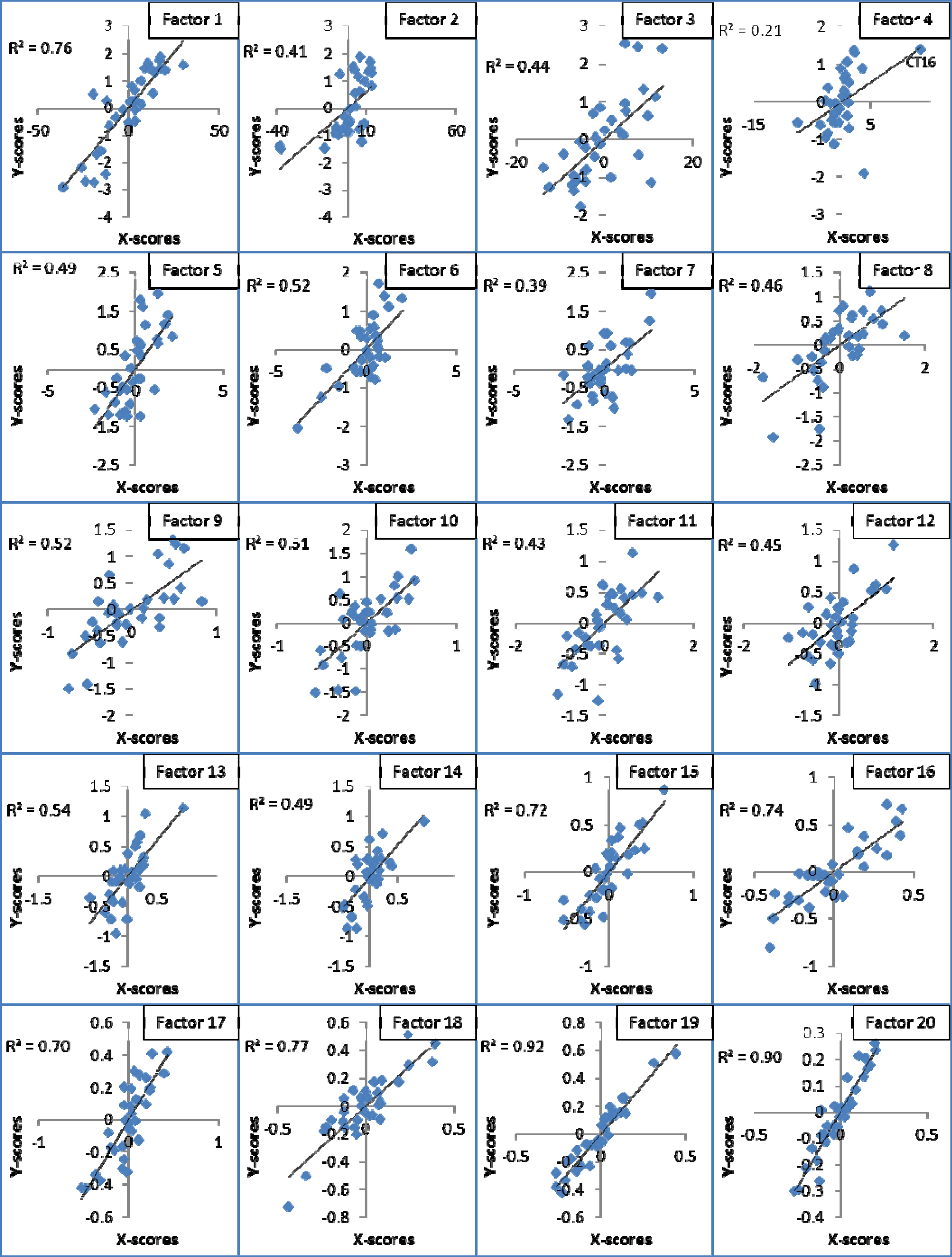


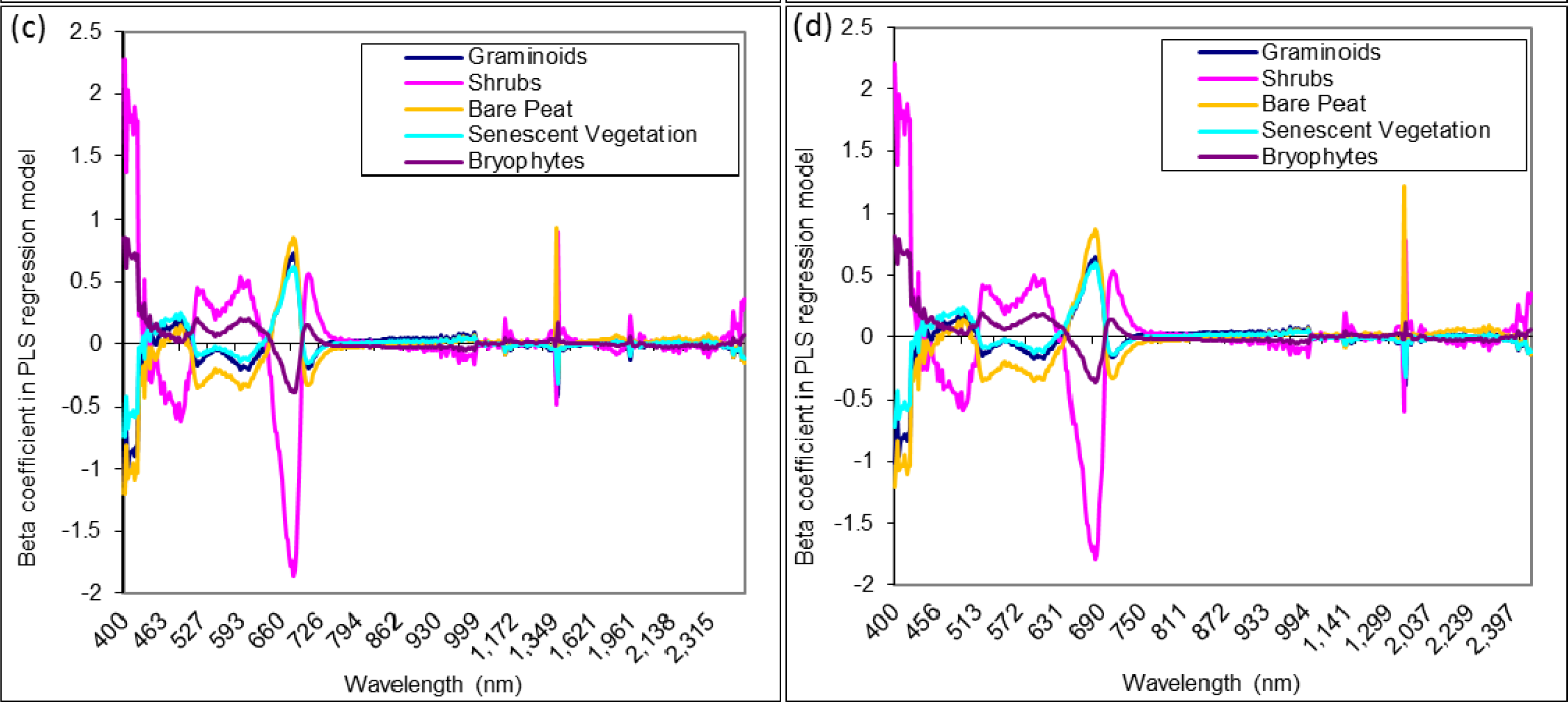
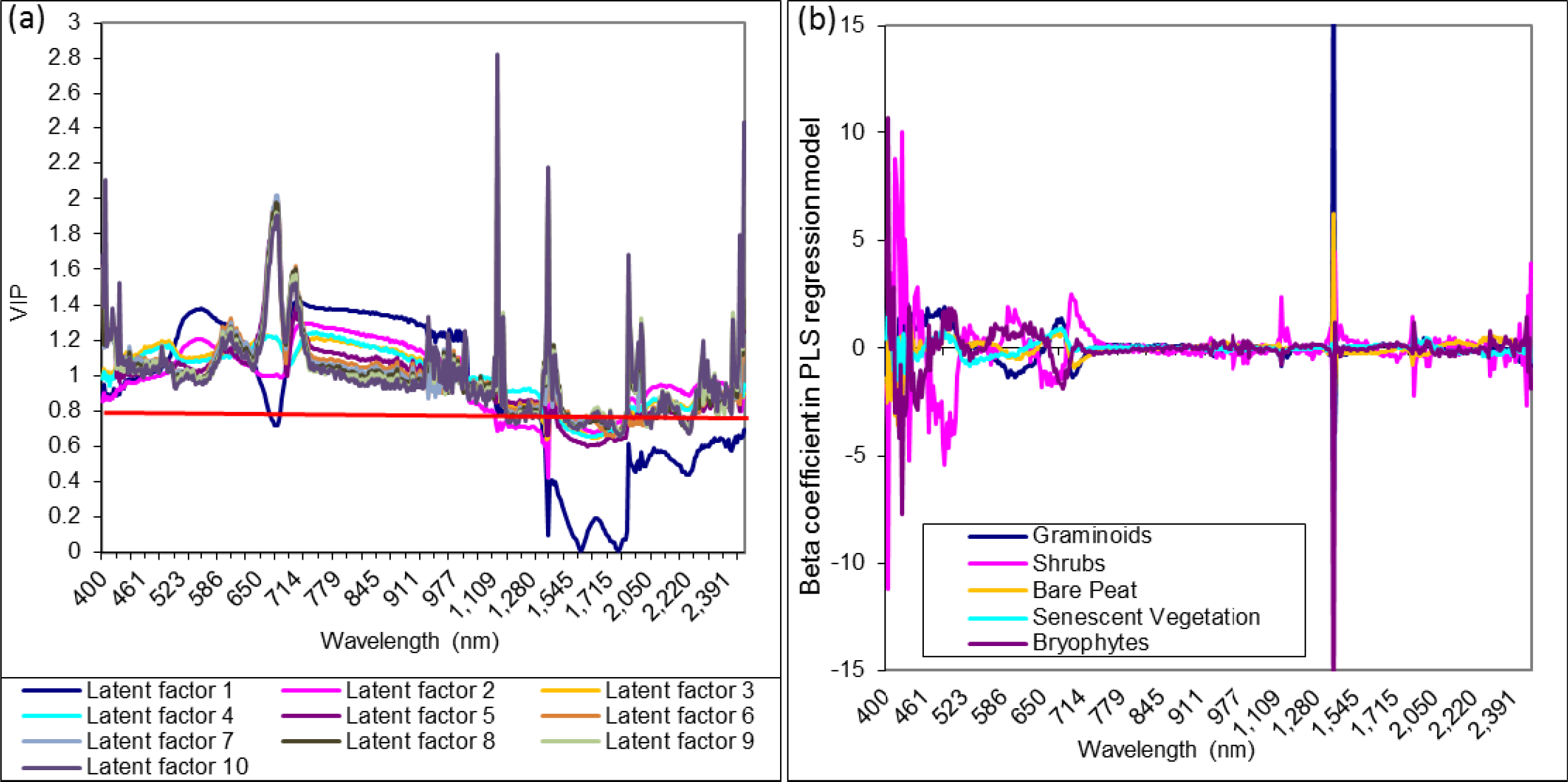
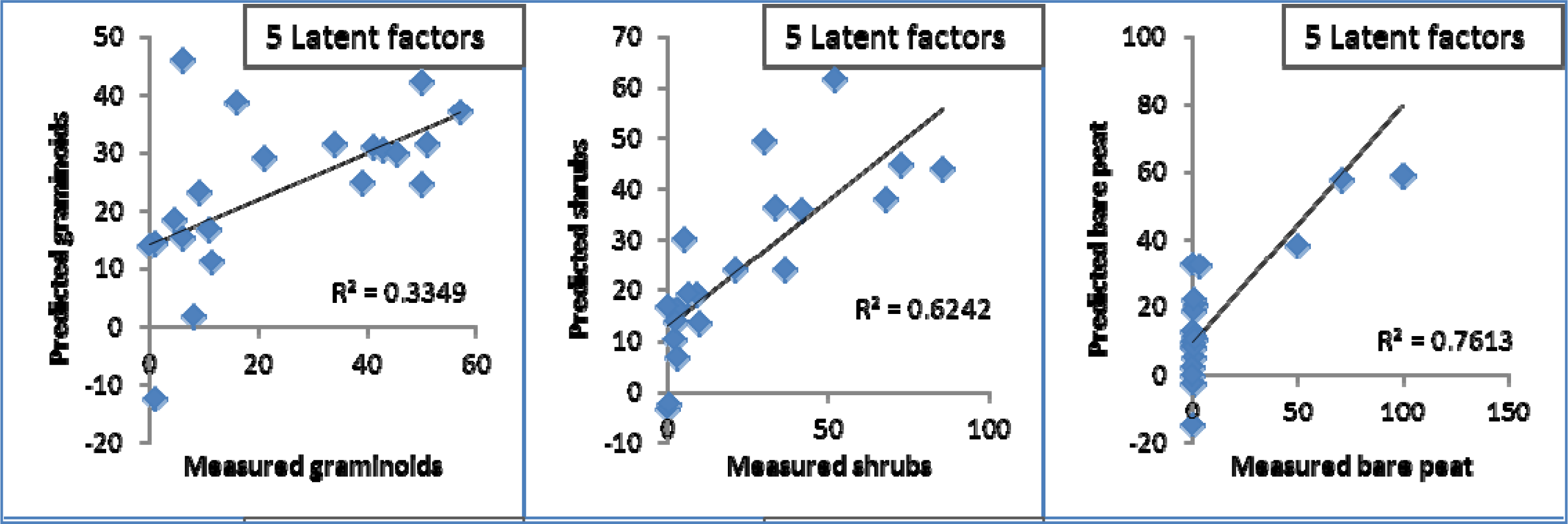

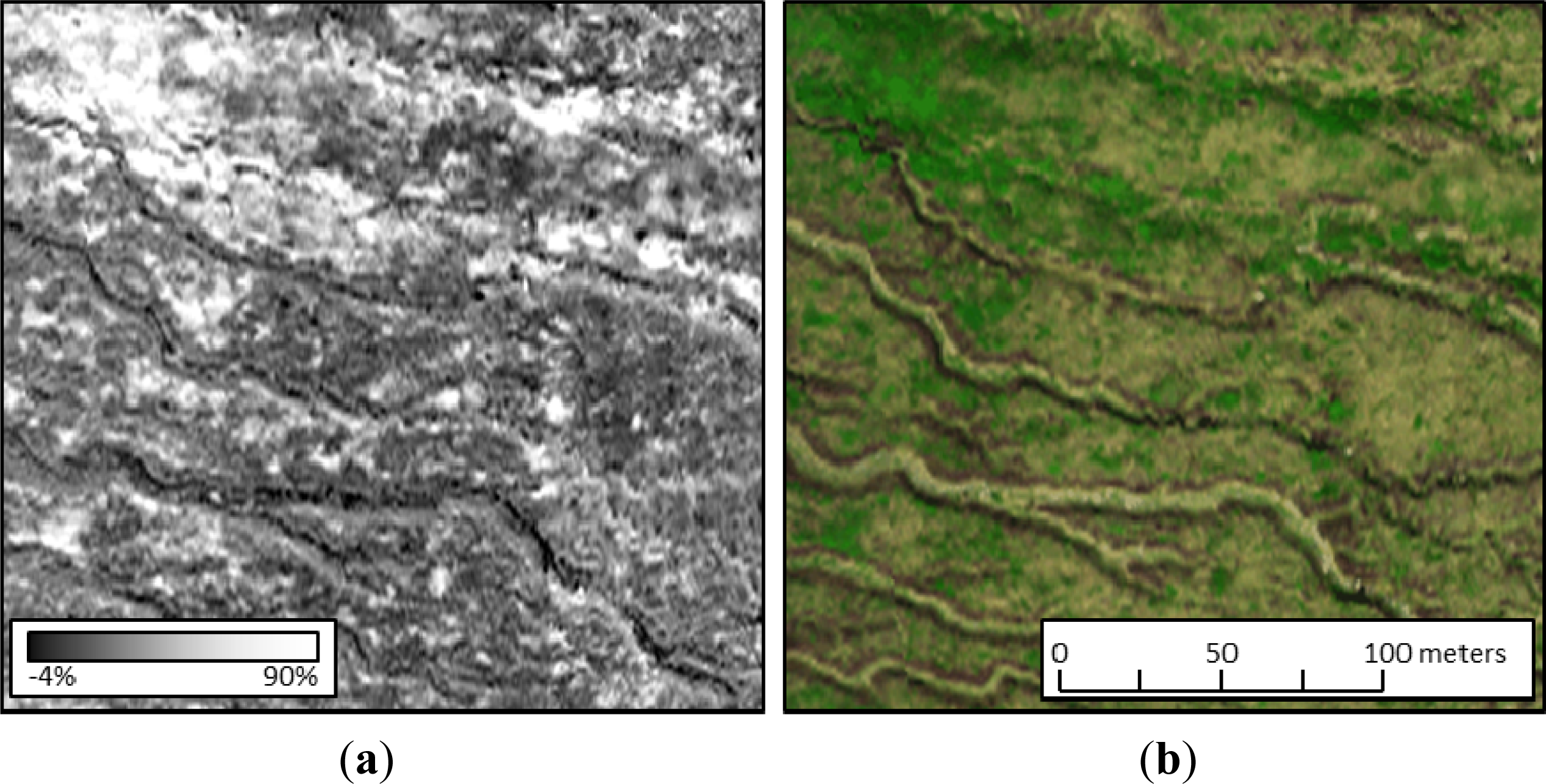

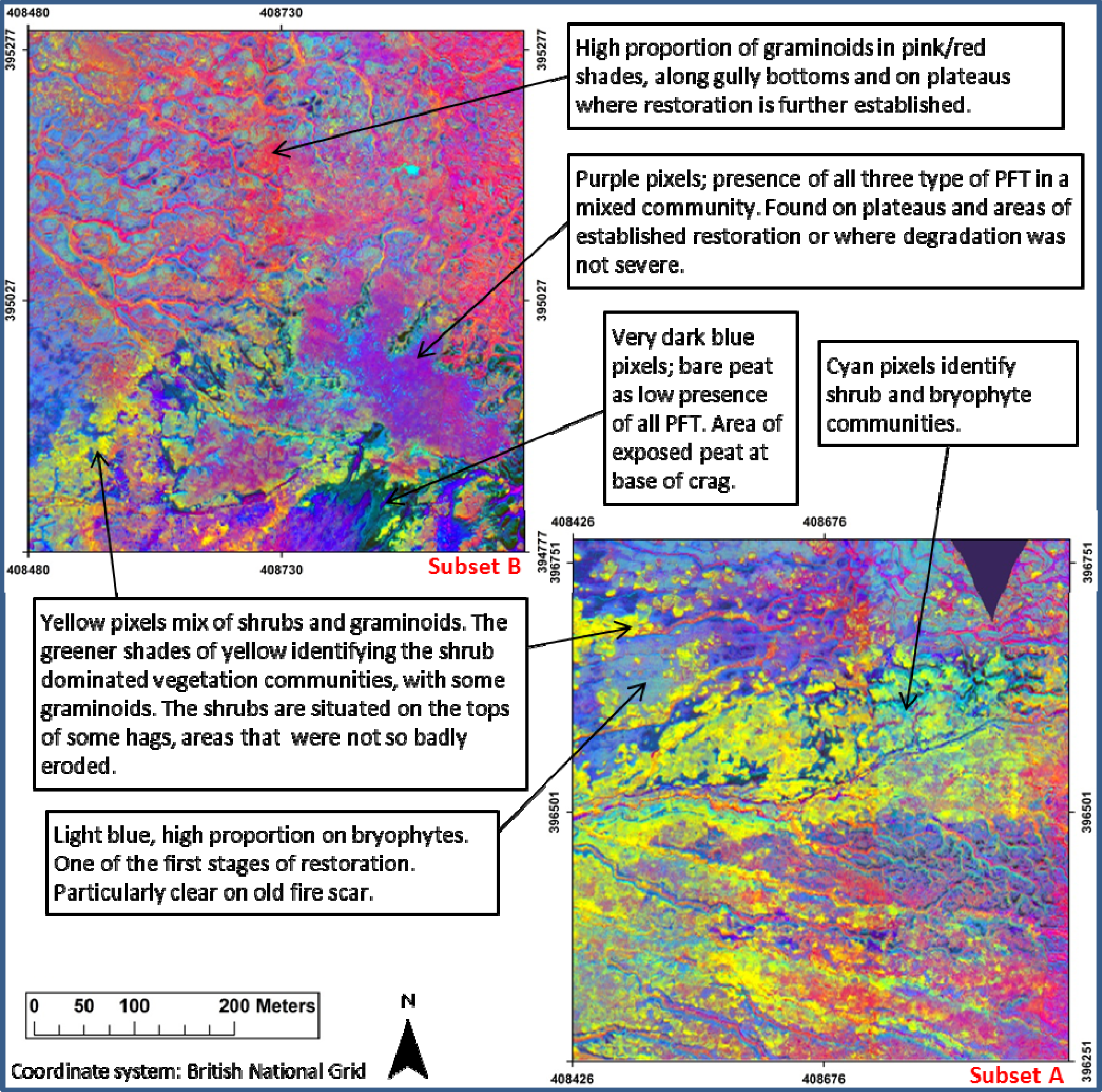
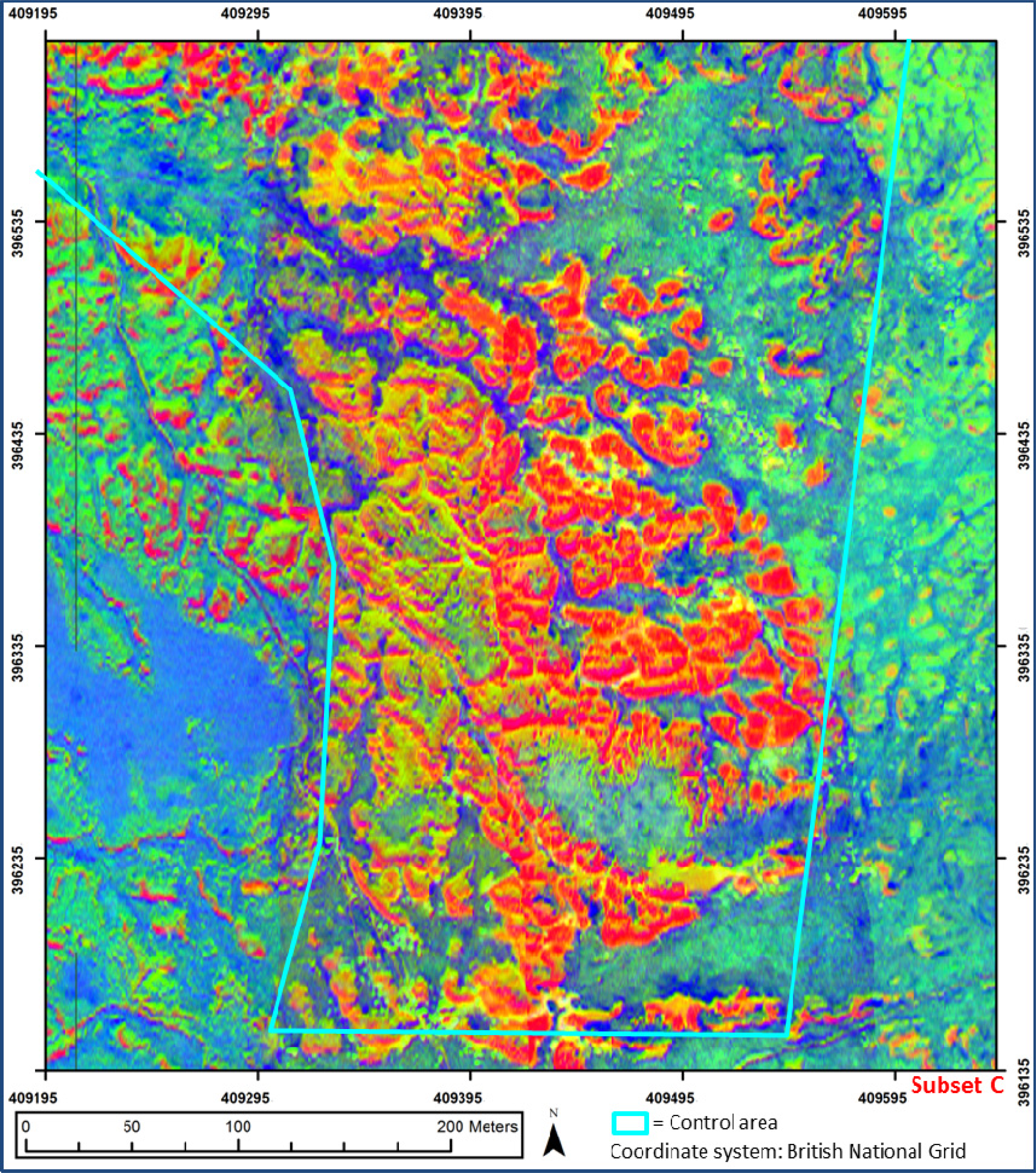
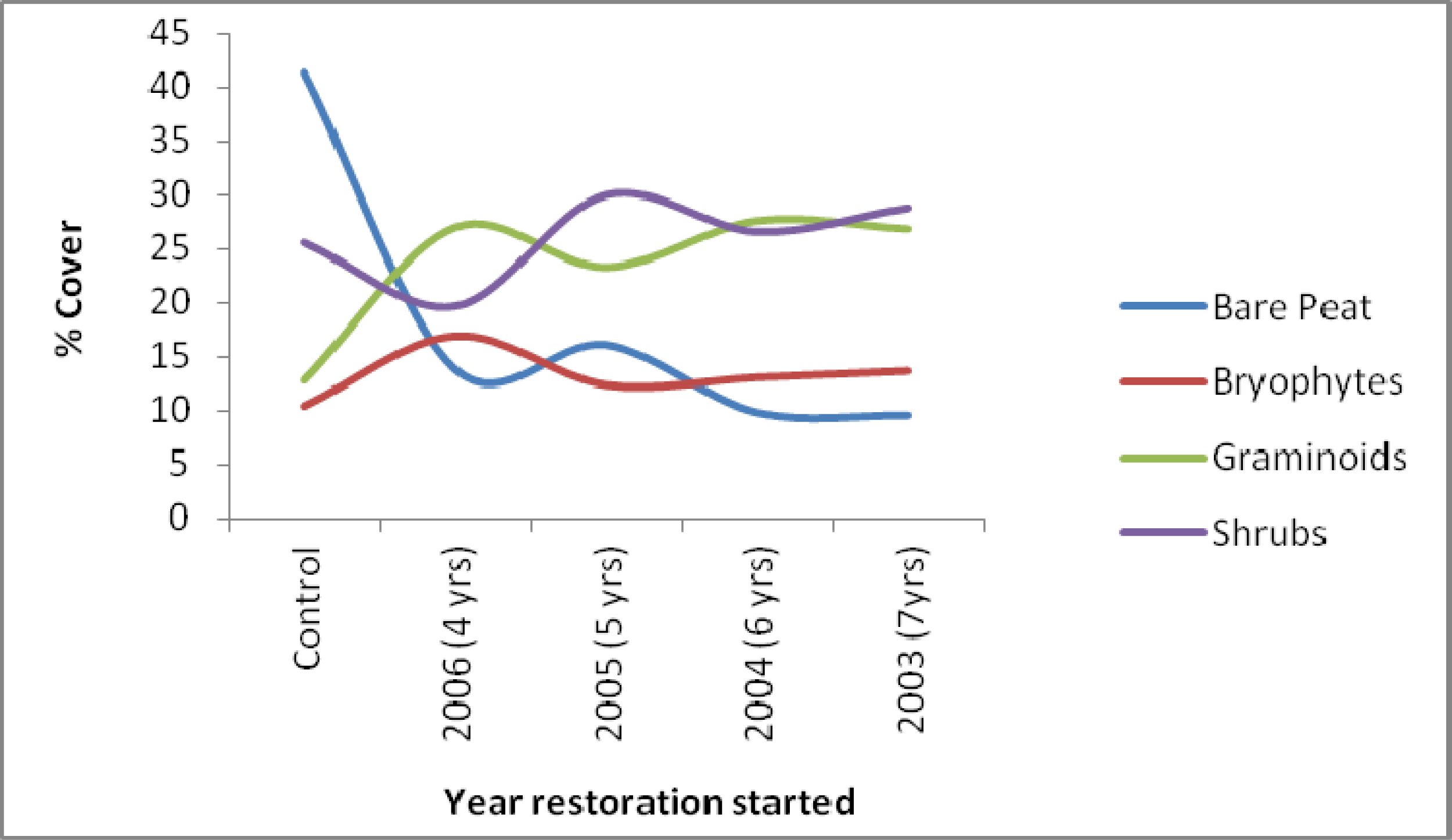
| Plant Functional Type | Key Species |
|---|---|
| Graminoids | Nurse (fine) grasses |
| Eriophorum angustifolium | |
| Eriophorum vaginatum | |
| Shrubs | Calluna vulgaris |
| Vaccinium myrtillus | |
| Bryophytes | Hypnum |
| Campylopus | |
| REP | VOG | CAI | PRI | PSRI | |
|---|---|---|---|---|---|
| Graminoids | −0.216 | −0.493 * | 0.113 | −0.112 | −0.315 |
| Shrubs | −0.240 | −0.501 * | 0.044 | −0.459 * | −0.816 * |
| Bryophytes | −0.346 | 0.418 * | 0.050 | −0.042 | 0.089 |
| Senescent vegetation | −0.293 | −0.220 | 0.183 | −0.064 | −0.056 |
| Bare peat | 0.338 | 0.702 * | −0.170 | 0.397 * | 0.614 * |
| Overall | Graminoids | Shrubs | Bare Peat | Senescent Vegetation | Bryophytes | ||
|---|---|---|---|---|---|---|---|
| 5 LF all variables | R2cal | 0.62 | 0.64 | 0.64 | 0.84 | 0.55 | 0.41 |
| R2val | 0.33 | 0.62 | 0.76 | 0.56 | 0.19 | ||
| RMSEcal | 20.09 | 18.41 | 27.68 | 22.75 | 14.89 | 13.14 | |
| RMSEval | 16.73 | 16.20 | 16.80 * | 16.81 | 10.02 * | 21.73 | |
| 5 LF reduced variables | R2cal | 0.62 | 0.63 | 0.63 | 0.85 | 0.55 | 0.41 |
| R2val | 0.34 | 0.61 | 0.76 | 0.56 | 0.18 | ||
| RMSEcal | 16.72 | 12.88 | 17.01 | 13.20 | 10.66 | 11.23 | |
| RMSEval | 13.19 | 16.08 | 17.04 | 16.54 | 10.11 | 21.76 | |
| 10 LF all variables | R2cal | 0.85 | 0.85 | 0.94 | 0.93 | 0.79 | 0.73 |
| R2val | 0.44 | 0.55 | 0.88 | 0.32 | 0.54 | ||
| RMSEcal | 7.74 | 8.15 | 6.70 | 8.74 | 7.29 | 7.64 | |
| RMSEval | 17.58 | 14.97 * | 24.24 | 13.62 | 13.13 | 19.36 | |
| 10 LF reduced variables | R2cal | 0.84 | 0.84 | 0.92 | 0.92 | 0.76 | 0.74 |
| R2val | 0.41 | 0.64 | 0.89 | 0.32 | 0.56 | ||
| RMSEcal | 8.36 | 8.54 | 8.06 | 9.73 | 7.76 | 7.52 | |
| RMSEval | 15.46 | 15.93 | 19.78 | 10.96 * | 13.03 | 16.11 * | |
| 20 LF all variables | R2cal | 1.00 | 1.00 | 1.00 | 1.00 | 1.00 | 0.99 |
| R2val | 0.39 | 0.58 | 0.90 | 0.53 | 0.44 | ||
| RMSEcal | 1.51 | 1.04 | 1.95 | 2.00 | 1.10 | 1.11 | |
| RMSEval | 23.66 | 30.66 | 24.00 | 21.55 | 13.54 | 25.19 | |
| Cover Type | Mean Predicted Abundance (%) from PLSR Image |
|---|---|
| Graminoids | 20.69 |
| Shrub | 25.52 |
| Bare Peat | 12.95 |
| Senescent vegetation | 15.96 |
| Bryophytes | 10.87 |
© 2014 by the authors; licensee MDPI, Basel, Switzerland This article is an open access article distributed under the terms and conditions of the Creative Commons Attribution license ( http://creativecommons.org/licenses/by/3.0/).
Share and Cite
Cole, B.; McMorrow, J.; Evans, M. Empirical Modelling of Vegetation Abundance from Airborne Hyperspectral Data for Upland Peatland Restoration Monitoring. Remote Sens. 2014, 6, 716-739. https://doi.org/10.3390/rs6010716
Cole B, McMorrow J, Evans M. Empirical Modelling of Vegetation Abundance from Airborne Hyperspectral Data for Upland Peatland Restoration Monitoring. Remote Sensing. 2014; 6(1):716-739. https://doi.org/10.3390/rs6010716
Chicago/Turabian StyleCole, Beth, Julia McMorrow, and Martin Evans. 2014. "Empirical Modelling of Vegetation Abundance from Airborne Hyperspectral Data for Upland Peatland Restoration Monitoring" Remote Sensing 6, no. 1: 716-739. https://doi.org/10.3390/rs6010716
APA StyleCole, B., McMorrow, J., & Evans, M. (2014). Empirical Modelling of Vegetation Abundance from Airborne Hyperspectral Data for Upland Peatland Restoration Monitoring. Remote Sensing, 6(1), 716-739. https://doi.org/10.3390/rs6010716




